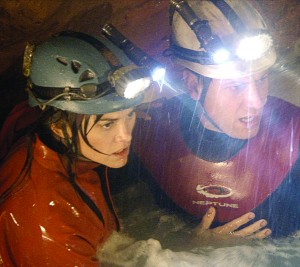Sanctum proves overly invested in story
The new 3-D film from Alister Grierson and James Cameron concerns an attractive bunch of spelunking junkies who must squeeze and swim their way out of the South Pacific’s Esa-ala cave system after a tropical storm submerges the main entrance.

Down under · Sanctum presents stereotypical stories and a typical narrative. The setting also fails to make the film’s actual location clear. - Photo courtesy of Universal Pictures
I’d like to think everyone responsible for Sanctum was wise enough to understand the picture’s limitations as a work of amusement. After all, patrons of Splash Mountain are not treated to an animatronic history of Brier Bear’s education and paternal estrangement. They hop in the boat, go down the chute and get soaked.
Instead, we are spared the gratification of cheap thrills and given a disposable father-son story that just happens to be set in a water tank. Josh (Rhys Wakefield) is a young Australian hunk who spends his time rock climbing and ferrying supplies to his distant, cave diver dad, Frank (Richard Roxborough).
We first meet Josh en route to the film’s caves, accompanied by American billionaire and expedition financier Carl Hurley (a dreadful Ioan Gruffud) and his dishy girlfriend, Victoria (Alice Parkinson).
Naturally, the three will wind up trapped, along with Frank, and are forced to deal with not only the usual bat droppings, stalagmites and subterranean pools, but also the company of each other.
Neil Marshall tried his hand at a similar setup with six young women and succeeded brilliantly in his 2005 creature feature The Descent.
But even before the monsters turned up, Marshall rendered the film’s granite halls, bottomless pitfalls and suffocating darkness almost unbearable to behold.
Grierson’s caves are grander in scale, but we never get a sense of just how deep beneath the earth we are. Though some might argue this disorientation is more akin to the true caving experience, I couldn’t shake the thought that after the ordeal, the film’s cast probably retired to a side room where hot towels, chicken dinners and mineral water awaited.
Part of the problem is the film’s pacing. Grierson gets us underground fast and floods the main tunnels before we’ve had a chance to look at them.
The reason for this, I suspect, is that the subterranean ceilings appear better in 3-D than the jungle above. Fair enough, but what the director does next is mystifying.
Instead of mercilessly exploiting his environment, Grierson takes us on a thumb twiddling journey through dark tunnels and the occasional submerged area, in the interest of mediating the characters’ frayed relationships.
Against all adversity, father and son grow inexplicably closer, as films of this melodramatic nature have taught us to expect.
That Grierson’s characters are hardly worth our interest doesn’t help. But even if their dilemmas were more thoughtfully realized and expressed, their exposition, slathered across the film’s midsection, belongs in the surface world.
The cave is where such exposition stands to be shaken up. As John Guillermin of The Towering Inferno and similar disaster pictures best demonstrated, it’s less important to have interesting characters than interesting ways to kill them off. Sanctum has neither.
Still, there is a good film waiting to be made about that perverse impetus that drives us to such unforgiving places in the Earth, beyond the conditioning of human compassion and reason. Werner Herzog took us there in Aguirre: The Wrath of God, with Klaus Kinski as our guide.
Though Sanctum’s Richard Roxburough lacks the German’s blinding spasms of madness, I occasionally found myself drawn to the former’s stubborn mass of obsession.
We never see Frank under sunlight, and get the sense that he might be immolated if ever brought back beneath its glare.
Unfortunately, that obsession is for another picture. Sanctum is not a successful character study or escapist thrill ride, but rather, another 3-D nail in the coffin of the filmed adventure.
The great blowhard Cameron appears to be wielding the hammer.
In theory, the director of Aliens and Titanic would be the ideal producer for a project like this, but if the capital exploits of Avatar seem to have convinced Cameron of one thing, it’s that completion lies solely in the exposed negative. We can only hope that Ron Jeremy’s next project won’t come with a pair of glasses.

Comments are closed.